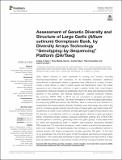Por favor, use este identificador para citar o enlazar a este item:
http://hdl.handle.net/10261/166543COMPARTIR / EXPORTAR:
 SHARE SHARE
 CORE
BASE CORE
BASE
|
|
| Visualizar otros formatos: MARC | Dublin Core | RDF | ORE | MODS | METS | DIDL | DATACITE | |

| Título: | Assessment of Genetic Diversity and Structure of Large Garlic (Allium sativum) Germplasm Bank, by Diversity Arrays Technology “Genotyping-by-Sequencing” Platform (DArTseq) |
Autor: | Ayllón Egea, Leticia CSIC; Mérida-García, Rosa CSIC; Kilian, Andrzej; Hernández Molina, Pilar CSIC ORCID ; Dorado, Gabriel | Palabras clave: | DNA fingerprinting Breeding Phenotype Somatic mutation Second-generation sequencing Third-generation sequencing (TGS) Next-generation sequencing |
Fecha de publicación: | 20-jul-2017 | Editor: | Frontiers Media | Citación: | Frontiers in Genetics 8: 98 (2017) | Resumen: | Garlic (Allium sativum) is used worldwide in cooking and industry, including pharmacology/medicine and cosmetics, for its interesting properties. Identifying redundancies in germplasm blanks to generate core collections is a major concern, mostly in large stocks, in order to reduce space and maintenance costs. Yet, similar appearance and phenotypic plasticity of garlic varieties hinder their morphological classification. Molecular studies are challenging, due to the large and expected complex genome of this species, with asexual reproduction. Classical molecular markers, like isozymes, RAPD, SSR, or AFLP, are not convenient to generate germplasm core-collections for this species. The recent emergence of high-throughput genotyping-by-sequencing (GBS) approaches, like DArTseq, allow to overcome such limitations to characterize and protect genetic diversity. Therefore, such technology was used in this work to: (i) assess genetic diversity and structure of a large garlic-germplasm bank (417 accessions); (ii) create a core collection; (iii) relate genotype to agronomical features; and (iv) describe a cost-effective method to manage genetic diversity in garlic-germplasm banks. Hierarchical-cluster analysis, principal-coordinates analysis and STRUCTURE showed general consistency, generating three main garlic-groups, mostly determined by variety and geographical origin. In addition, high-resolution genotyping identified 286 unique and 131 redundant accessions, used to select a reduced size germplasm-bank core collection. This demonstrates that DArTseq is a cost-effective method to analyze species with large and expected complex genomes, like garlic. To the best of our knowledge, this is the first report of high-throughput genotyping of a large garlic germplasm. This is particularly interesting for garlic adaptation and improvement, to fight biotic and abiotic stresses, in the current context of climate change and global warming. | Versión del editor: | http://dx.doi.org/10.3389/fgene.2017.00098 | URI: | http://hdl.handle.net/10261/166543 | DOI: | 10.3389/fgene.2017.00098 | E-ISSN: | 1664-8021 |
| Aparece en las colecciones: | (IAS) Artículos |
Ficheros en este ítem:
| Fichero | Descripción | Tamaño | Formato | |
|---|---|---|---|---|
| allium_sativum_Egea.pdf | 444,04 kB | Adobe PDF |  Visualizar/Abrir |
CORE Recommender
PubMed Central
Citations
22
checked on 26-mar-2024
SCOPUSTM
Citations
65
checked on 15-abr-2024
WEB OF SCIENCETM
Citations
55
checked on 23-feb-2024
Page view(s)
327
checked on 15-abr-2024
Download(s)
274
checked on 15-abr-2024

